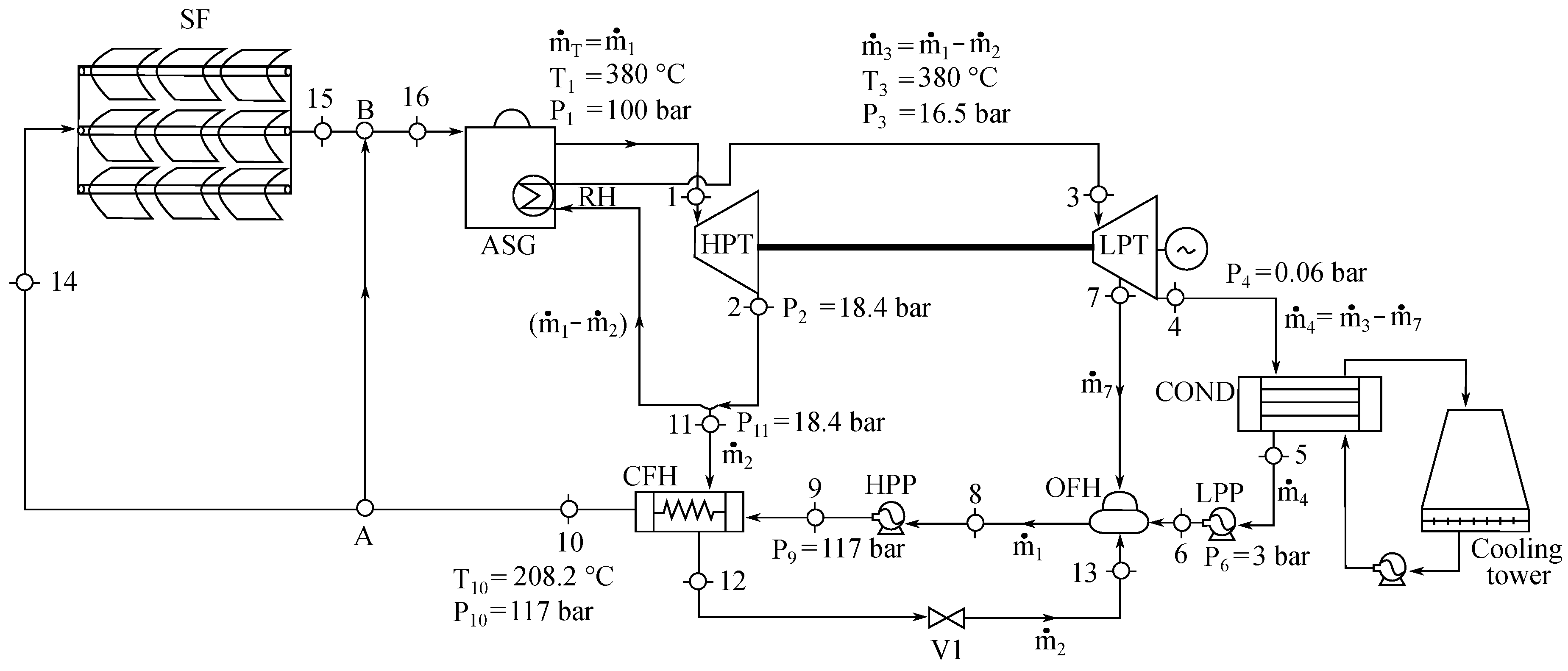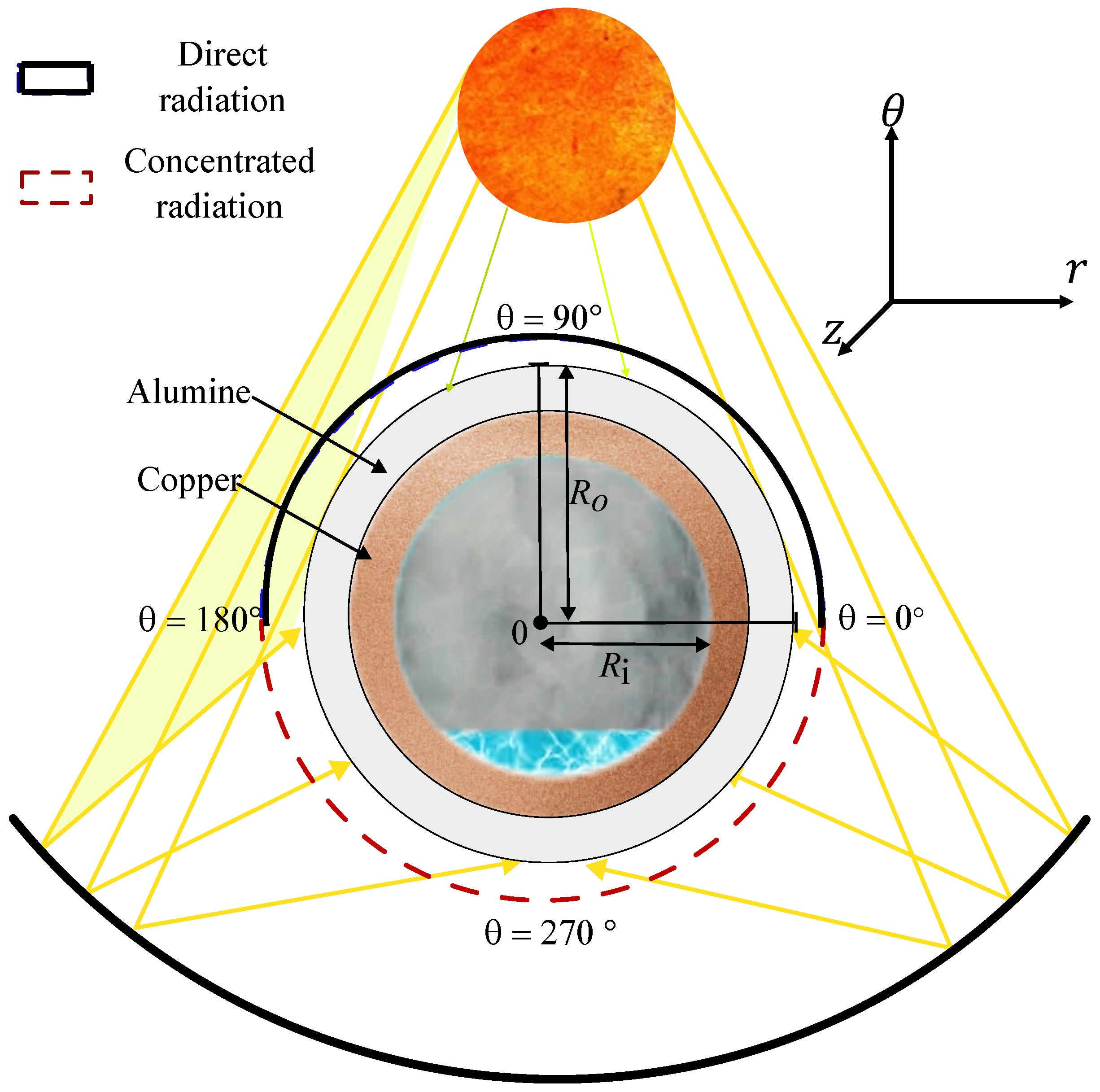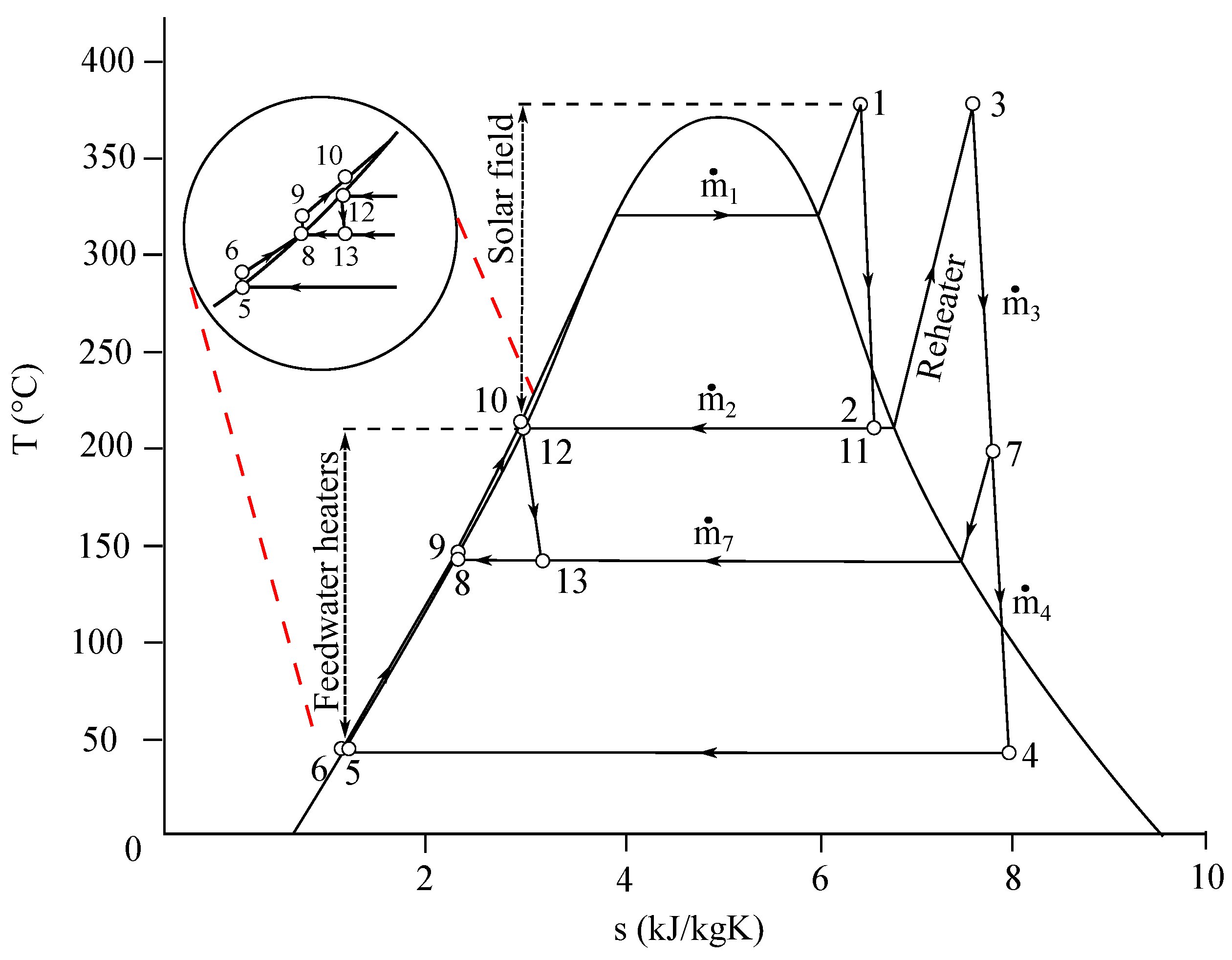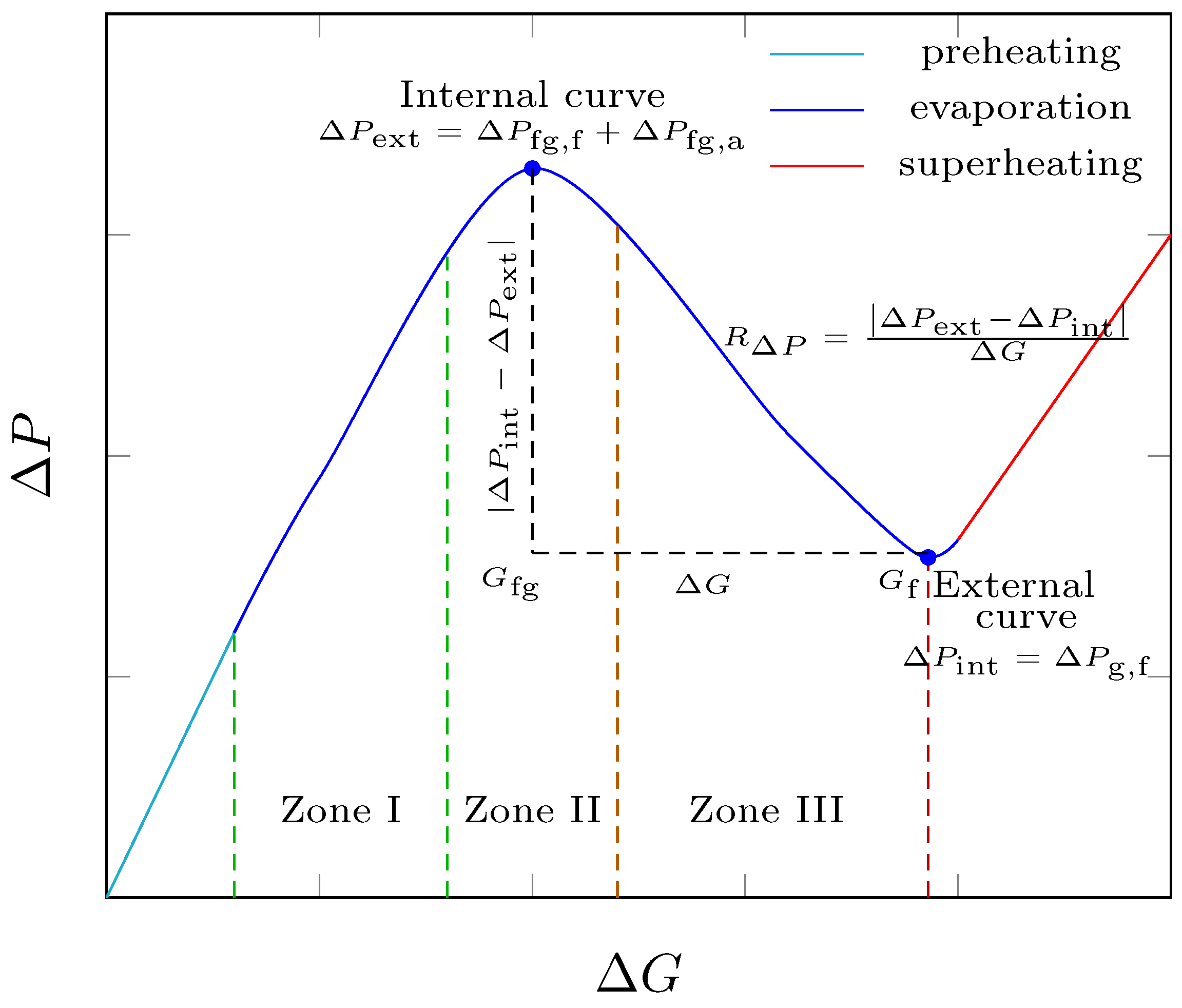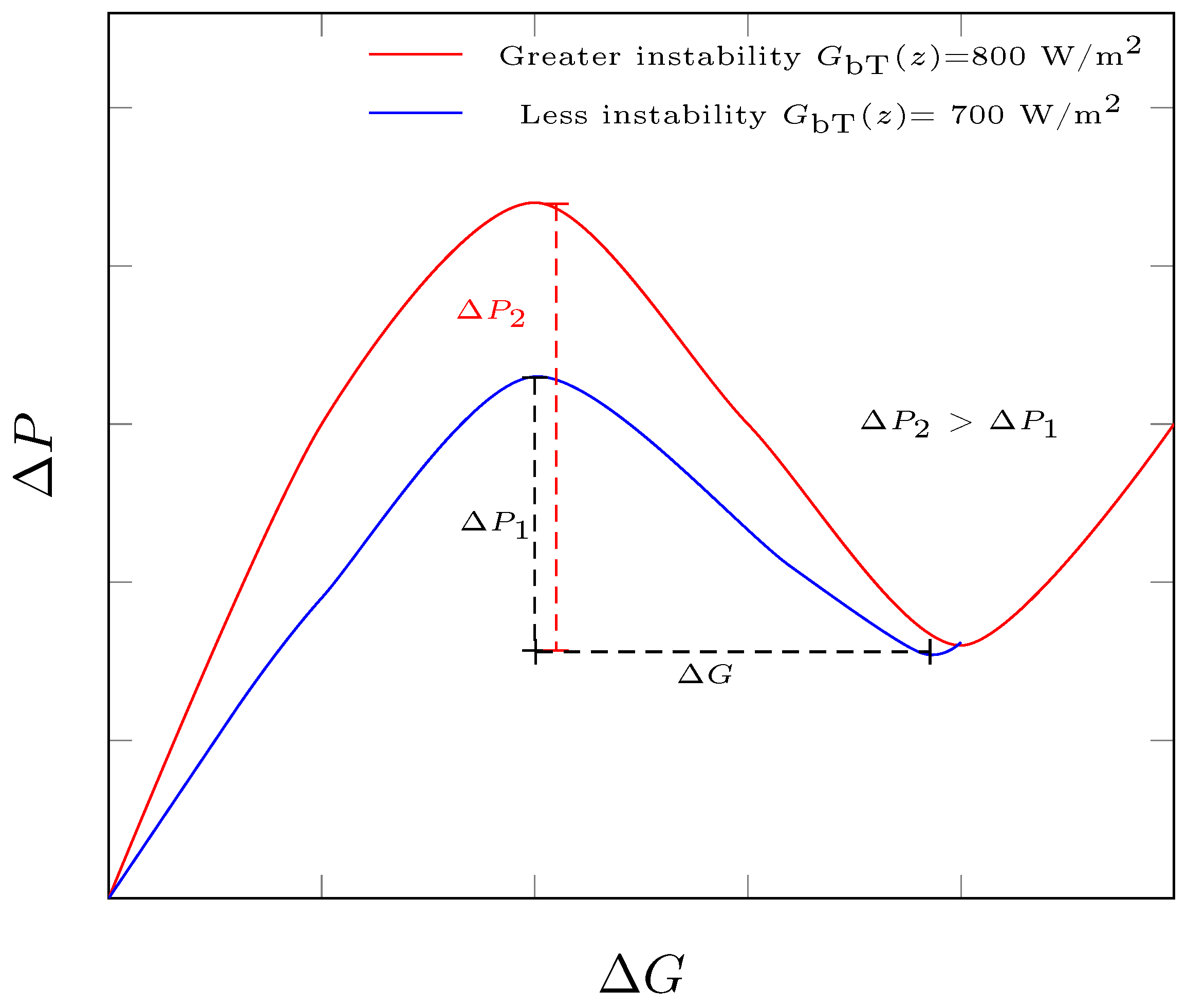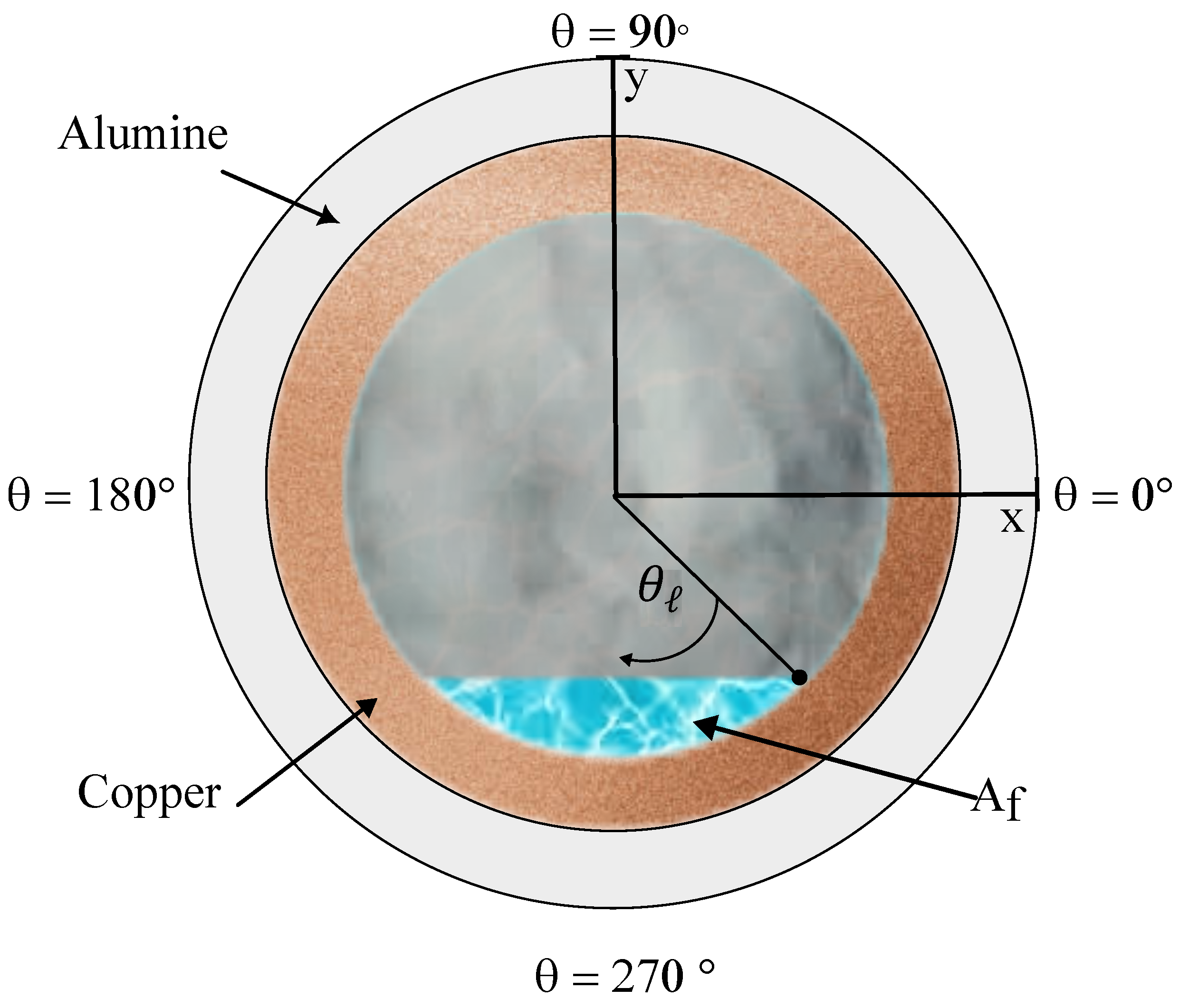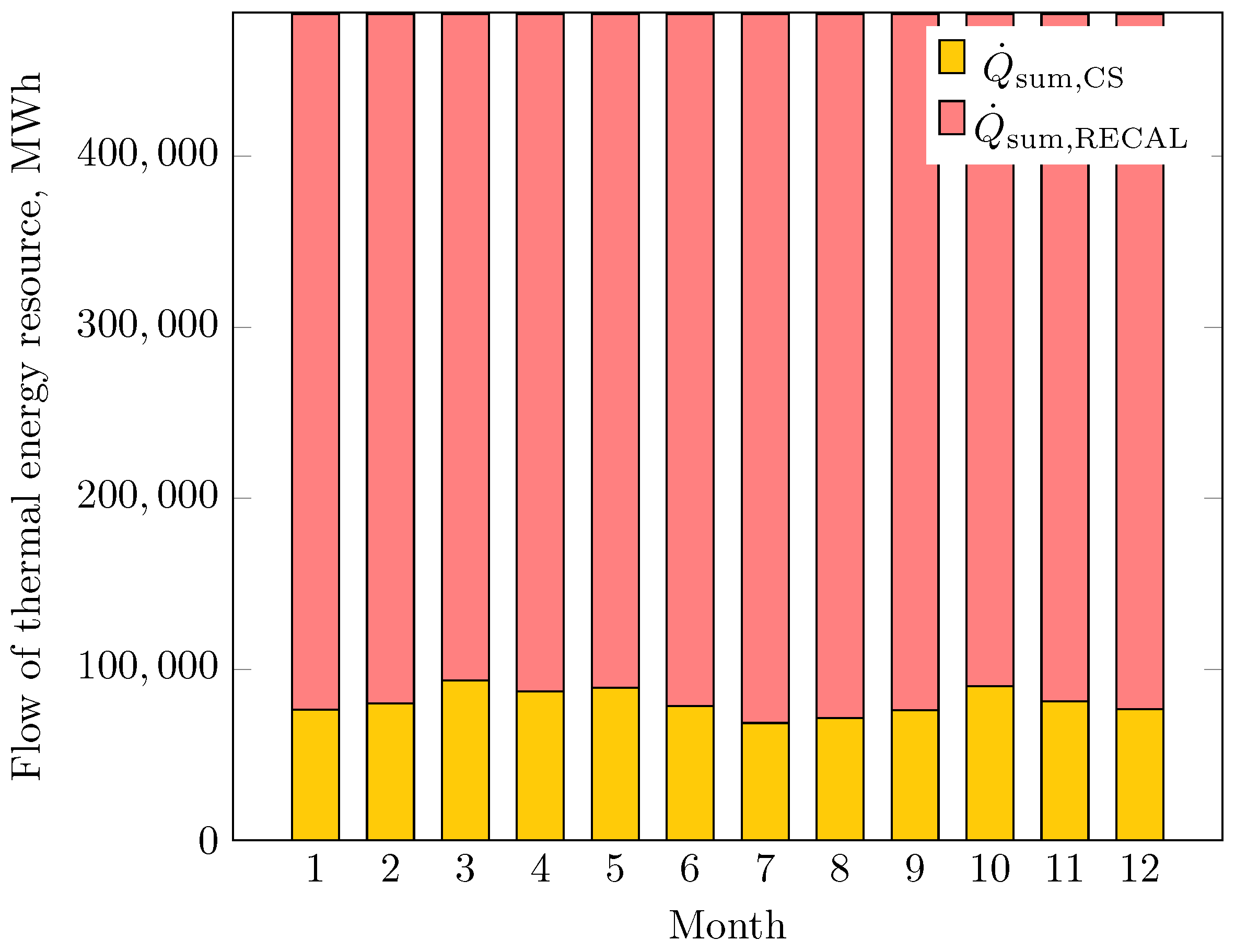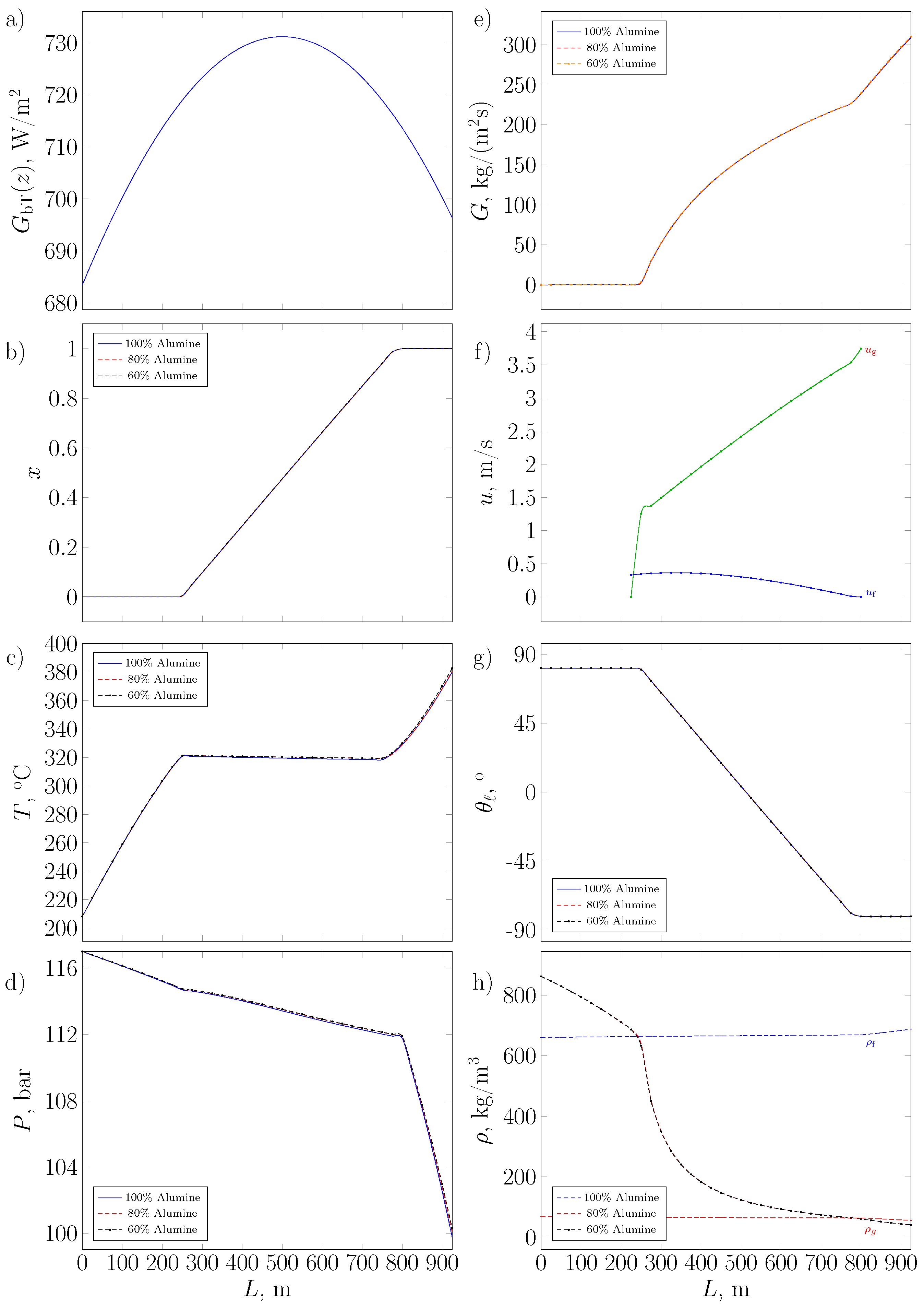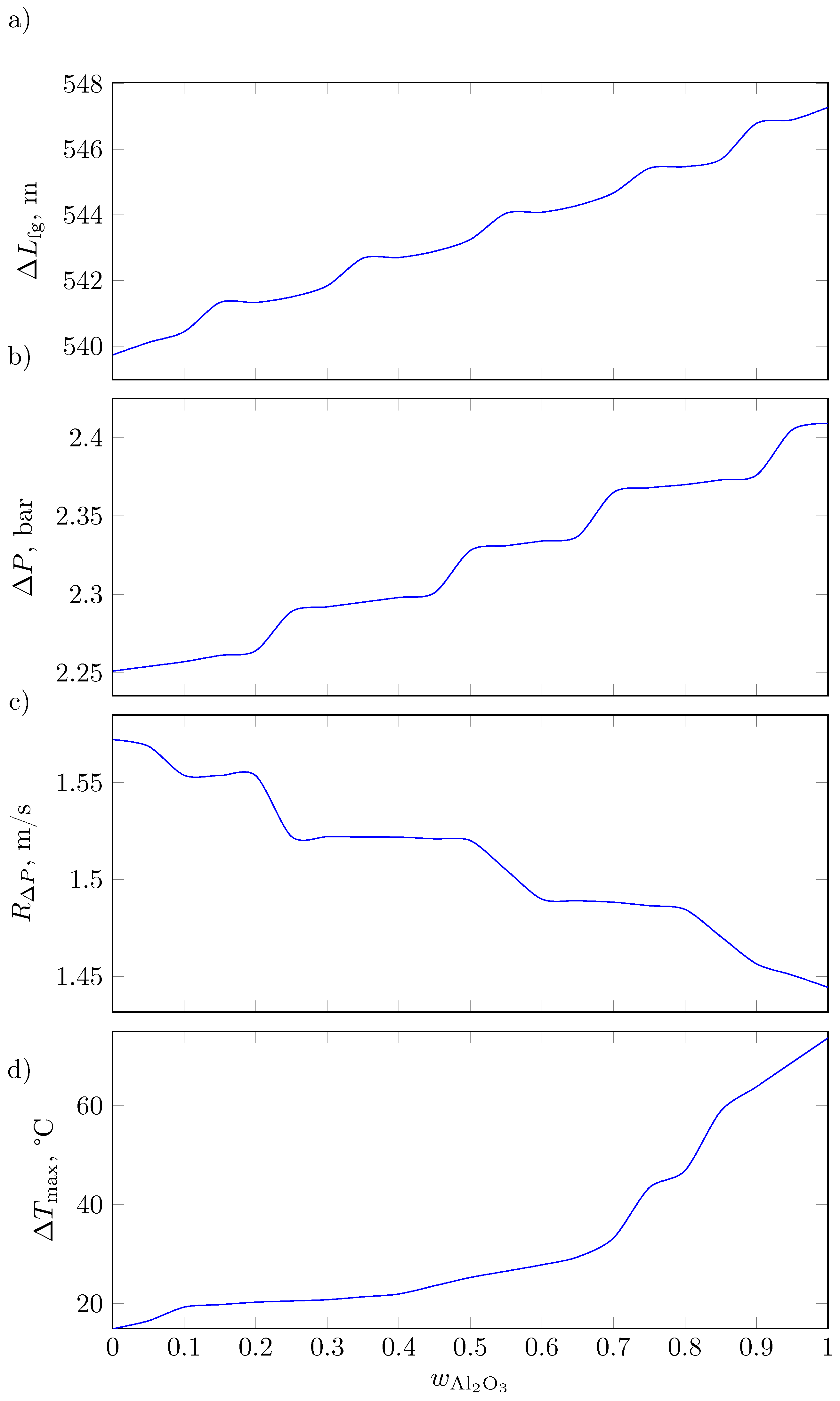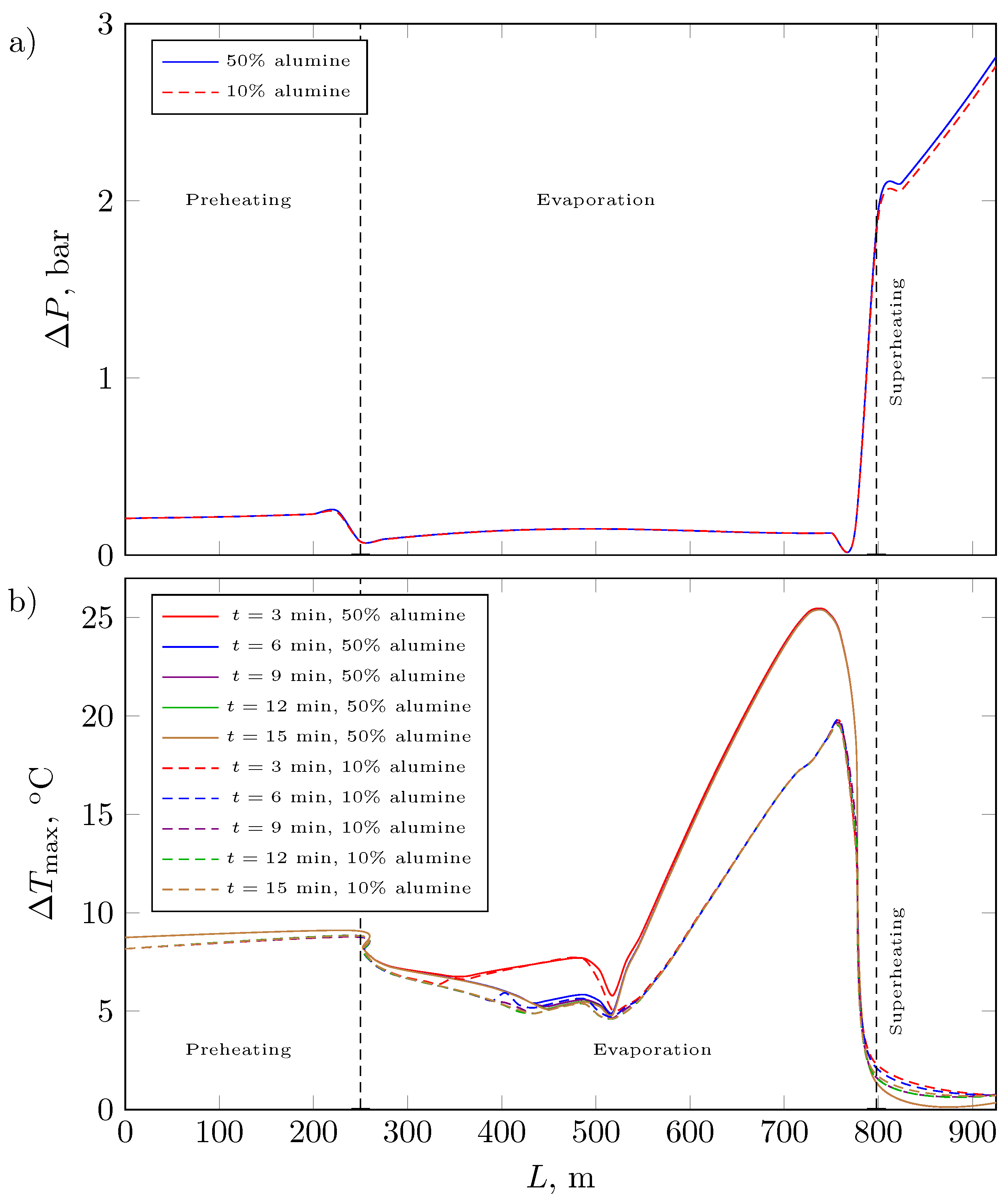1. Introduction
Hybrid solar plants are designed to address various environmental and social problems, thus contributing to the transition toward more sustainable energy systems [
1]. Solar technologies are integrated with other renewable-energy sources or storage systems to reduce dependence on fossil fuels, thus reducing greenhouse gas emissions as well as mitigating climate change and its environmental impact. This not only offers direct environmental benefits but also fosters broader awareness concerning the importance of sustainable-energy solutions [
2,
3].
Advances in the design of these plants [
4] have resulted in the development of programmable electronic systems to monitor environmental parameters and manage electrical functions in solar thermal plants. In a previous study, a control unit was designed to acquire data from temperature and light sensors, process information, and control external devices (pumps, electric valves, and power supplies) to improve plant performance, maximize efficiency, and achieve energy savings.
Direct steam generation (DSG), which is a parabolic trough solar technology, uses a parabolic trough concentrator that focuses solar energy on each receiving tube to generate steam and drive a power-generation system. DSG offers the advantages of low operating cost and high thermal efficiency as it does not require additional heat exchangers and does not lose a significant amount of heat when heat is transferred from thermal oil to steam [
5,
6,
7,
8]. However, owing to the possibility of uneven flow distributions and other instabilities related to liquid–vapor flow in parallel pipelines, DSG technology has not been adopted for commercial applications. Various studies pertaining to the instability of two-phase flows in vertical pipes have been conducted [
9,
10,
11,
12,
13,
14]. In the nuclear industry, two-phase flows in parallel pipes are of great interest because of the instability that occurs in boiling-water reactors and loss-of-cooling accidents. Instability problems such as pressure drop oscillations, density wave oscillations, and flow paths have been discussed comprehensively; consequently, useful conclusions have been obtained, which have been practically applied in engineering [
15]. The instability of two-phase flows in horizontal pipes is governed primarily by the relationship between fractional pressure drop and flow rate.
Ref. [
16] performed a detailed thermoeconomic analysis on a solar thermal plant applied to greenhouses. The main objective was to technically and economically evaluate a well composed of gravel and water that was strategically located in a greenhouse to utilize the available space therein. The analysis was distinguished by its original focus on the loading and unloading phases over one year of operation based on the effective hourly heating demand and actual meteorological data. In the study, sensitivity analysis was performed to determine the levelized cost of heat by considering key variables such as the solar-collector area and storage-well volume. The results revealed the possibility of a design solution with minimum costs that can fulfill 100% of the heat demand, with an estimated levelized heat cost of 153.3 EUR/MWh. These findings highlight the economic viability of thermal energy storage systems as an effective option for mitigating the environmental impact of greenhouses. In this study, a hybrid solar thermal plant is investigated numerically to evaluate the effect of the Cu-Al
2O
3 ratio in the receiving tube on the working fluid.
Simulations and numerical analyses of solar thermal systems are essential for understanding complex processes as well as for energy, economic, and environmental evaluations. In this study, a hybrid solar thermal plant is investigated numerically to evaluate the Cu-Al2O3 ratio effects in receiving tubes on system performance. This work presents five fundamental contributions:
The development of system architecture and plant design introduces a 50 MWe hybrid solar thermal facility for Mulegé, Mexico. The design establishes operational parameters (380 °C, 100–117 bar), methods for solar field sizing, and optimal configuration with 87 loops of six concentrators each. This base design provides the foundation for subsequent analyses.
A Cu-Al2O3 composite wall receiver tube combines thermal conductivity from copper with stability from alumina in a 50–50 ratio. Numerical analysis demonstrates that this configuration reduces pressure drop by 3.3% compared to pure alumina tubes while maintaining structural integrity. The composite design balances thermal efficiency with mechanical stability.
The characterization of flow dynamics identifies and models three distinct regions within receiver tubes: preheating, evaporation, and superheating. The analysis develops two-phase flow pressure drop models and methods for analyzing stratified flow patterns, establishing critical relationships between solar irradiance and flow instability magnitude.
Heat transfer modeling presents mathematical frameworks describing interactions between composite materials and working fluid. The models incorporate angle-dependent boundary conditions and thermal interface behavior, characterizing thermal contact resistance and expansion effects at material interfaces.
The integrated mathematical framework encompasses all aspects of system design and operation. This includes equations for solar field sizing, mass and energy conservation models, and correlations for geometric and thermal properties. The numerical results validate the proposed models and demonstrate that mechanical instabilities primarily affect the copper portion, while thermal instabilities impact the alumina portion of the composite wall.
The remainder of this article is structured as follows:
Section 2 introduces the hybrid solar plant design and describes key system components, with an emphasis on the Cu-Al
2O
3 composite receiver tubes.
Section 3 presents the solar field sizing methodology and theoretical framework, including radiation distribution analysis.
Section 4 develops the mathematical models for flow regions and instabilities in the receiving tube, while
Section 5 establishes the heat transfer analysis in the composite wall.
Section 6 presents numerical results focusing on thermal and mechanical instability effects in different regions of the composite receiver tube. Finally,
Section 7 provides conclusions and implications for future solar thermal plant designs.
2. System Description of Hybrid Solar Plant
This study proposes the installation of a hybrid solar thermal plant with direct steam generation of 50 MW
e, as shown in
Figure 1, in Mulegé, Baja California Sur, Mexico. This site features high solar potential and is in a remote area, which cannot access electricity supplied by the national power grid [
17].
The hybrid solar thermal power plant (see
Figure 1) features an SF that operates during the solar irradiance interval to produce superheated steam, which is used as input to the high-pressure turbine (HPT) of the power cycle. The solar field concentrator loops operate in the single-pass mode [
18]. During periods of solar intermittency or absence, the flow from the SF is extracted from wet steam to superheated steam (SHS) via an auxiliary boiler (ASG) to achieve the conditions required in the HPT (#1). The auxiliary boiler in the proposed hybrid solar plant operates during periods of insufficient solar irradiance, specifically activating after 16:00 and deactivating at 10:00 the following day. Its role is critical to maintaining continuous electricity production, ensuring the financial viability of the plant even without thermal storage systems. While the auxiliary boiler does not directly impact the overall thermal efficiency of the plant, its integration allows for a stable output by compensating for variations in solar energy availability. This design choice highlights the importance of hybrid configurations in balancing renewable energy integration with consistent power generation. The wet steam exiting the HPT is reheated in the reheater (RH) to reach the SHS at a temperature of 380 °C via the combustion of natural gas (#2 to #3) and then input to the low-pressure turbine (LPT) (#3). The wet vapor exiting the LPT is condensed in a condenser (COND) (#4) to obtain water in a saturated liquid state (#5). The pressure of this liquid-water flow is increased through its passage through the low-pressure pump (LPP) to obtain compressed liquid water (#6), thus preventing counterflow between the currents originating from the extraction of the LPT (#7) and closed heater (CFH) (#12). To reduce the dimensions of the SF, steam extractions are performed in the HPT (#11) and LPT (#7) to preheat the liquid-water flows supplied to the SF in the CFH and open heaters (OFHs), respectively. The pressure of the water flowing out of the OFH increases to that required by the SF (in this case, 117 bar) in the high-pressure pump (HPP) (#9). To satisfy the temperature requirements of the water upon entry into the SF, the flow of water exiting the HPP (#9) is heated in the CFH (#10).
Meanwhile, the function of a parabolic trough solar concentrator is to capture and concentrate solar irradiance on its surface and subsequently reflect it on the lower external wall of the receiving tubes. The irradiance received by the receiver is calculated using the geometric concentration ratio,
, which is the ratio of the collection areas of the receiving tube
to the area of the concentrator parabola
.
Figure 2 shows the cross-section of the composite wall receiving tube, where
is the outer radius of the alumina,
the inner radius of the copper, and
the opening angle. In this case, direct and concentrated contributions are considered in the upper (
) and other regions (
) of the wall of the alumina receiving tube, respectively. In other words, for
, the solar radiation is normal and uniform, and for
, the radiation originates from the surface of the concentrator. In this case, the radiation in the concentrator is 24.8 times greater than that received at the top.
4. Flow Regions in Receiving Tube During DSG
In the DSG, three different flow regions are exhibited along its path in the concentrator loop: preheating, evaporation, and superheating. The phase of the water flow that circulates through the concentrator loop depends on the availability of solar resources and the mass flow. If the direct solar irradiance incident on the receiver is high or the mass flow is low, then, at the exit of the loop, the water flow may appear as a liquid, liquid–vapor mixture, or superheated vapor.
In the preheating region, the water undergoes heating and remains in a compressed liquid state until it reaches the saturation state. At the exit of the loop, the specific enthalpy of the water satisfies .
In the evaporation region, water changes from a saturated liquid to a saturated vapor and passes through a liquid–vapor mixture. In this region, stratified flow can occur during the day owing to differences in water density caused by changes in the temperature of the thermal fluid, which consequently results in variations in solar radiation. As the fluid warms up, it becomes less dense and tends to ascend and accumulate at the top of the receiving tube, where solar radiation is the most intense, whereas the colder, denser fluid tends to sink. The specific enthalpy of water at the exit of the loop is bounded based on . Meanwhile, the quality of water along the loop is between 0 and 1.
In the superheating region, the water transforms from saturated vapor to superheated vapor, and at the exit of the loop, its enthalpy satisfies .
The functionality of the enthalpy of water with the axial component (
z) of the concentrator loop is determined from the energy conservation balance at the cross-section of the tube, which is centered on
z and measures
[
32] long. The energies in transit that generate a change in the energy state of the water in this section is the mass flow of water at the inlet and outlet and the heat flow produced by the irradiance incident on the receiver. Thus, the enthalpy as a function of the axial position of the loop is expressed as
where
is the enthalpy at the entrance of the loop,
G the ratio between the mass flow of water and the cross-sectional area of the loop
,
the hydraulic diameter of the receiving tube, and
the length of the loop cross-section centered on
z. The length of the cross-section in terms of the captured solar irradiance and enthalpies is expressed as follows:
where
and
are the perimeter and cross-sectional areas, respectively. Next, the characteristic lengths of the different flow regions are determined using Equation (
21).
The heat transfer coefficient between the internal wall of the receiving tube
, the stratified phases of liquid (f) and vapor (g), and the associated Reynolds number is expressed as follows [
33]:
where
is the thermal conductivity of the tube in
or Cu-
,
the density of the phase,
the viscosity of the phase obtained using the
Xsteam water software, and
the velocity of each phase in the stratified flow.
4.1. Water Pressure Along Loop of Receiving Tube
The pressure of water flowing through the receiving tube loop is determined as follows:
where
is the pressure drop in each flow region of the receiving tube and is determined from the force balance without considering the gravity term owing to its horizontal characteristics. The pressure drop of water between the inlet and outlet of the loop is expressed as
where
, and
denote the pressure drops in the preheating, evaporation, and superheating regions, respectively. For the unmixed preheating and superheat regions, the pressure drops were primarily because of friction between the water flow and the inner wall of the receiving tube.
where
f denotes the Darcy friction coefficient for laminar or turbulent flow [
34]. In the evaporation region, water in liquid–vapor equilibrium is assumed to exhibit a layered or stratified flow pattern. For a two-phase flow in the evaporation region, the pressure drop is contributed to by two factors: one is the acceleration
resulting from the phase change, and the other is the friction
between the flow of liquid water and the wall of the receiver.
To perform force balance in the evaporation region, the pressure drop due to the acceleration of the liquid–vapor mixture is estimated as follows:
where
x is the vapor quality,
, and
is the volume fraction of vapor in the liquid–vapor mixture [
35]:
where
g is the acceleration due to gravity and
is the surface tension of water. Finally, the friction in the pressure drop in the liquid–vapor mixture is estimated as follows [
36]:
4.2. Flow Instability in Evaporation Region
Flow instability occurs when a fluid in the vapor phase expands abruptly in a liquid–vapor mixture during phase transition. This phenomenon causes fluctuations in the pressure, temperature, and flow rate of the fluid. In DSG, these fluctuations can affect the receiving tube, such as via vibrations and local overheating on the receiving tube because of a decrease in the heat transfer coefficient between the fluid and tube wall.
Figure 4 shows the behavior of the pressure drop with respect to the mass flow of water in the evaporation region of the concentrator loop. In this region, the pressure drop of the liquid–vapor mixture along the loop,
, as expressed by Equation (
27), has a component associated with the acceleration of the vapor phase,
, as expressed by Equation (
28), and another related to the friction of the liquid with the wall,
, as expressed by Equation (
30). This behavior indicates the presence of flow instability, also known as evaporation velocity, which is visualized in
Figure 4 as an oscillation of pressure drops, whose characteristic curve is “N”-shaped and is the union of the internal curves (blue curve—concave downward) and external curves (red curve—concave upward).
Throughout the oscillation, the components of the pressure drop in the evaporation region were competing with each other, thus causing a change in the concavity of the oscillation. This allowed us to identify the following areas of instability evolution:
Zone I: The fall of because the acceleration of the vapor phase dominates, i.e., . This area corresponds to the expanding portion of the internal curve.
Zone II: The pressure drops because the acceleration of the vapor phase and the friction of the liquid with the wall have the same order of magnitude, i.e., . This zone corresponds to the set of points of the oscillation traversing from the crest (maximum internal curve) to the trough of the oscillation and contains the inflection point of the oscillation.
Zone III: Pressure drops due to the friction of the liquid with the wall are dominant, i.e., . This area coincides with the expanding region of the external curve.
The magnitude of flow instability is estimated using the slope,
in m/s, of the straight line that passes through the crest (maximum of the internal curve) and valley (minimum of the external curve) of the oscillation [
36]:
Figure 5 shows the influence of the incidence of effective solar irradiance that affects the receiver and that is transferred to the mass flow of water that circulates along the loop on the magnitude of the instability. The greater the solar irradiance absorbed by the receiver and supplied to the working fluid, the greater the instability magnitude. Consequently, the pressure drops because the acceleration of the steam and the friction between the wall and water have the same order of magnitude.
4.3. Liquid Elevation Angle in Stratified Flow Pattern
In the
plane, the liquid elevation angle,
, is the angle formed by the
y axis and the radius of the internal wall of the receiving tube that intersects the liquid surface of the stratified liquid–vapor flow, as shown in
Figure 6. This angle varies as the liquid water evaporates along the receiving tube and is thus a function of the liquid–vapor mixture quality. The angle of elevation of the liquid is useful for determining the surfaces of the inner wall of the tube that are in contact with the liquid and vapor phases. Therefore, it facilitates the establishment of boundary conditions at the fluid–internal wall interface of the tube.
In this study, the liquid elevation angle for a liquid–vapor mixture that reflects a stratified flow pattern, based on [
37], is expressed as the liquid surface area in terms of the product of the cross-sectional area of the receiving tube and the mass fraction of liquid in the liquid–vapor mixture. Additionally, it can be expressed as a function of the radius and internal angle of the wall of the receiving tube,
and
.
The numerical solution to the previous equation is obtained using the Newton–Raphson method. Using linear regression, the following correlation was obtained for
as a function of quality for different compositions in the composite wall of the receiving tube, based on a correlation coefficient of 0.9994 and values
= 0.00332 m
2,
= 0.035 m, and
= 0.72 kg/s.
Once the internal angle of the receiving tube wall is defined, the velocities of each phase are expressed as follows:
5. Heat Transfer in Copper–Alumina Composite Wall of Receiving Tube
To determine the heat transport in the composite wall of the receiving tube, the study is separated into cases for alumina (
) and copper (
) based on the schemes shown in
Figure 2 and
Figure 6. The equations that model the transport and angle
-dependent outer boundary conditions for the
-region over the total length of the loop or
are as follows:
where
denotes the solar irradiance expressed in Equation (
7) and
is the ratio of the collection area of the receiving tube to that of the concentrator parabola, as expressed in Equation (
1). The boundary conditions at the entrance and exit of the system are specified as thermal insulation. For the boundary condition between alumina and copper, heat continuity is considered because heat dissipation occurs through direct contact. Although both the materials are good conductors, some resistance to heat transfer through the interface occurs because of imperfections, surface roughness, and microscopic air spaces [
38].
This resistance is typically quantified as the thermal contact resistance. Additionally, copper and alumina have different coefficients of thermal expansion, which can cause dimensional changes when heated or cooled. This difference in thermal expansion can cause stress at the interface, which can result in mechanical problems if not considered in the design [
39]. In this case, the contributions of stress at the interface, as well as those of radiation and convection owing to their thickness, are disregarded. This is based on Fourier’s law of heat conduction, in which the rate of heat transfer per unit area is proportional to the temperature gradient across two different materials [
40,
41]. In the case of copper and alumina, the heat flow across the interface is continuous, which ensures a constant heat transfer. Therefore, the average characteristics of copper and alumina were considered in the design systems for effective heat transfer. Meanwhile, the thermal properties at the Cu–Al
2O
3 interface (or
–
interface) were estimated from the arithmetic average of the property of each corrected material.
where
assumes the values of the thermal properties
k,
, and
in each case and
and
are the material fractions of copper and alumina, respectively. For copper (
region), three flow regions that occur during steam generation were established: preheating
, evaporation
, and superheating
. Subsequently, a differential equation and boundary conditions were established by considering thermal insulation at the entrance and exit of the system.
where
and
are the convective heat transfer coefficients for the liquid water and vapor phases, respectively, as expressed in Equation (
23), and
,
, and
are the water temperatures in the preheating, evaporation, and superheating regions, respectively, which are obtained from Equations (
20) and (
24). In Equations (
37d) and (37e),
is the elevation angle of the liquid in the evaporation region and is determined from Equations (
32) and (
33).
For a detailed description of the numerical methodology used for the heat transfer analysis in the composite wall of the receiver, please refer to
Appendix B, where the procedure is outlined using COMSOL Multiphysics software.
6. Results
The heat flow requirements that the SF and RH must provide to supply 483,228.00 MWh/month to the power cycle for the plant to generate 50 MW
e and operate at 100% throughout the year are shown in
Figure 7. The heat flow contributed by the SF was between 14% and 19% of the total thermal energy requirement. This contribution reaches its minimum during winter and its maximum at the beginning of spring. Because of this solar intermittency, the ASG supplies between 81% and 86% of the thermal energy to the power cycle. Based on these results, the sizing of the SF of the hybrid solar plant was performed.
During the spring solstice, the solar thermal plant generates 50 MW
e and is supplied with
= 113.21 MW
th and
= 113.21 MW
th to achieve a water flow of
= 53.01 kg/s with a thermal efficiency of
= 0.41. Under the design conditions established in
Section 3 and the equations presented in
Section 3.3, the powers generated by the HPT and LPT as well as the power requirements of the HPP and LPP are presented in
Table 1.
For the sizing of the SF, it is assumed that the receiving tube comprises a borosilicate glass cover and a wall composed of 50% copper UNS 12200 Cu and 50% alumina Al2O3, whose thickness is with = 0.035 m and = 0.030 m. The thickness of the Cu and Al2O3 walls is 0.0025 m.
Table 2 lists the design characteristics of the SF obtained from the assumptions established in
Section 3 and the application of the sizing equations. The U-shaped SF comprises 87 loops composed of six concentrators with length
m connected in series.
Figure 8a shows the profile of the direct irradiance incident on the receiving tube in the axial direction during the spring solstice. This profile was used to estimate the thermodynamic and transport properties of water along the concentrator loop and the elevation angle of the liquid in the evaporation region for different Cu-Al
2O
3 ratios in the composite walls of the receiver tubes.
Figure 8b shows the vapor quality profile along the evaporation region of a concentrator loop for Al
2O
3 ratios of 60%, 80%, and 100%, This figure indicates that preheating occurred in the first 250 m, the evaporation region with
began at 250 m and ended between 789.73 and 797.28 m of the loop, and overheating occurred between the final 141.25 and 127.72 m. The length of the evaporation region increased with the percentage of alumina in the receiver wall because the thermal conductivity of alumina is ten times lower than that of copper.
Figure 8c shows that, in the preheating region, the water temperature increased from 208.2 °C to approximately 321.05 °C for the different compositions on the wall of the receiving tube. In the evaporation region, the water temperature remained at approximately 320.02 °C. Finally, in the superheating region, the water temperature increased from approximately 320.08 °C to approximately 383.04 °C.
Figure 8d shows the pressure profiles along the concentrator loop. In the preheating region, the water pressure at the receiving tube wall decreased from 117 bar to approximately 114.77 bar for different compositions. In the evaporation region, the water pressure decreased from approximately 114.77 bar to 111.92 bar. Finally, in the superheating region, the pressure decreased from 111.92 bar to approximately 100.44 bar. At first glance, this figure presents a continuous pressure drop along the loop; however, in the transition between the evaporation and superheating regions, an increase in water pressure of 0.12 bar occurred between 760 and 795 m.
Figure 8e shows the increase in mass flow of the vapor phase along the concentrator loop in the evaporation and superheating regions. The mass flow growth rate in the evaporation region was lower than that in the superheating region because of the increase in the vapor fraction in this zone. The decrease in the slope of the mass flow between 760 and 795 m, as shown in
Figure 8d, increased the pressure drop, which increased the magnitude of the flow instability in the transition region between evaporation and overheating.
Figure 8f shows the behavior of the fluid and vapor velocities. The fluid velocity remained constant at 0.25 m/s along the loop until the phase changed to vapor, at which it decayed to 0. Meanwhile, the vapor velocity increased from 0 to 1.5 m/s in the loop up to 250 m. Subsequently, it increased linearly up to 760 m and then increased in the final section of the loop, which was in accordance with the changes in the pressure drop.
Figure 8g shows that the elevation angle of the liquid in the preheating region was 0.88, whereas the elevation angle with respect to the axial direction decreased linearly in the evaporation region.
Figure 8h shows the density of the working fluid as it traversed through the concentrator loop. In the preheating region, the density of liquid water decreased from 862.63 kg/m
3 to approximately 686.23 kg/m
3 for the different receiver tube compositions. In the evaporation region, the density of the mixture decreased gradually until it reached approximately 686.25 kg/m
3. In the superheating region, the density of the mixture decreased to 40.997 kg/m
3 for the different compositions. Changes in the density increased the magnitude of flow instability, which was primarily owing to the increase in pressure drop since the changes in the mass flow were less significant [
42].
To determine the effect of the Cu-Al
2O
3 ratio of the composite wall of the receiving tubes on the DSG in the evaporation region, the effect of the composition of the composite wall of the receiving tubes on the length is presented in
Figure 9. Additionally, the effects of the composition of the composite wall of the receiving tubes on the length, pressure drop, and magnitude of flow instability in the evaporation region is presented. This figure shows that an increase in the proportion of alumina in the composite wall of the receiving tube increased the magnitude of the evaporation region, pressure drop, and maximum temperature difference on the wall of the receiver, whereas it decreased the magnitude of flow instability owing to the increase in thermal conductivity. In addition, it decreased the steam temperature at the outlet of the concentrator loop.
In this study, a 50% Cu–50% Al2O3 proportion was considered for the sizing of the SF to manage the magnitudes of flow instability and maximum intermediate tube wall temperature differences that favor the mechanical integrity and thermal properties of the concentrator loop. Notably, the proportion is available commercially. Under this proportion, the saturation condition was attained 3.14 m earlier than in the case of the 100% alumina wall. When comparing the effect of 50% and 100% Al2O3 on the walls of the receiving tube, the pressure drop reduced by 3.3%, the magnitude of flow instability increased by 5.03%, and the difference in the maximum temperatures was 48.37 °C. Considering the result based on 40% Cu–60% Al2O3 and comparing it with that of the 100% Al2O3 wall, the instability magnitude increased by 3.06%, the saturation condition was attained 3.02 m before the wall with 100% Al2O3, and the pressure drop reduced by 3.1%, and the reduction in the maximum temperature difference was 44.23 °C.
The composite wall was evaluated (
) at times
, and 15 min, as shown in
Figure 10.
Figure 11 shows the behavior of the temperatures in the cross-section of the wall composed of 40% Cu and 60% Al
2O
3 of the receiving tube for
z = 629 m at times
t = 3, 6, 9, 12, and 15 min during the spring solstice.
The highest temperature of the wall of the receiving tube with a proportion of 40% Cu–60% Al2O3 was analyzed in the hot spot formation zone for t = 15 min.
Figure 12 shows that the highest temperature of the tube was 618.11 K, which was located on the external wall (
) at
198°, 217°, i.e., the location where the concentrated direct solar irradiance exerted its effects.
7. Conclusions
The dynamics of the numerical solution of the model was analyzed in the cross-sections of the composite wall. In this regard, a value for z was set, and the effects of r and on the maximum temperature difference in the composite wall were evaluated ().
In the preheating region, increased with the length of the concentrator loop by approximately 0.656 °C/m and 0.354 °C/m for 10% and 50% alumina, respectively. In this region, the numerical solutions for different proportions of alumina reached the steady state rapidly because, when comparing a solution at time with that at time , the difference increased from 0.03 to 1.47 °C. This indicates that, at any instant, the wall temperature was almost uniform.
In addition, in the evaporation region, presented between five and six changes in the concavity with respect to the length of the concentrator loop. These concavities were different from those of as a function of z. These behaviors suggested coupled mechanical and thermal instabilities.
Thermal behavior at the tube wall showed abrupt changes in the , e.g., for the 50% alumina, increased from 9.1 °C at the beginning of the evaporation region (z = 250 m and ) to 4.6 °C for m () and subsequently reached a global maximum at 25.2 °C for m ().
The evaporation region zone that included the maximum value of was between 744.6 and 760.1 m for 50% and 10% alumina proportions. In this area, hot spots appeared on the tube wall, accompanied by pressure increases from 0.128 to 1.94 bar.
These numerical results are consistent with the experimental evidence of the receptor softening and deformation [
43,
44]. In addition, in the superheating region,
did not exceed 0.5 °C, thus indicating that the temperature on the tube wall was uniform.
In the receiving tube for z = 629 m at times t = 3, 6, 9, 12, and 15 min, hot spots appeared between 517.1 m () and 729.3 m () in the evaporation region at ; meanwhile, in the preheating and superheating regions, the wall temperature was almost uniform.
The highest temperature of the tube was 618.11 K, which was located on the external wall () at 198°, 217°, i.e., the location where the concentrated direct solar irradiance exerted its effects. Meanwhile, the lowest temperature of 602.13 K was indicated at = 90°, where direct solar irradiation exerted its effects.
The maximum differences in each solid phase of the composite wall of the receiving tube were 10.86 °C and 4.37 °C, and the minimum differences were 0.25 °C and 0.04 °C for alumina and copper, respectively. Owing to its thermal properties, copper favored the transfer of heat to the working fluid, whereas alumina, which is a ceramic material, served as a thermal deposit that suppressed the softening effects in the solid phase of copper. These results indicate that the alumina wall reduced the effects of thermal instability that would occur in an alumina-free copper tube, which would result in the deformation of the tube with the effects of flow instabilities.
